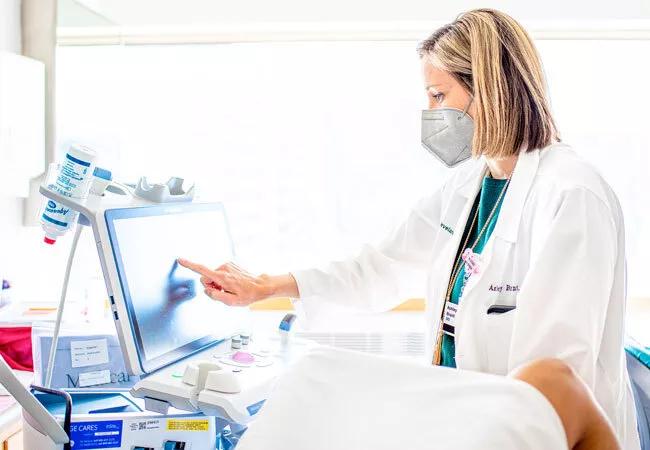Cleveland Clinic gathers resources to meet reproductive health needs

Immediately after the June 24 U.S. Supreme Court decision overturning federal protection for abortion rights, Cleveland Clinic moved quickly to ensure that patients continue to receive comprehensive, compassionate reproductive health care.
Advertisement
Cleveland Clinic is a non-profit academic medical center. Advertising on our site helps support our mission. We do not endorse non-Cleveland Clinic products or services. Policy
Those continuing efforts include a focus on:
“We are deeply committed to supporting our patients with empathetic, evidence-based health care, and to connect them to the resources they need, whether that’s from within Cleveland Clinic or with colleagues elsewhere,” says Tristi Muir, MD, chair of the Ob/Gyn & Women’s Health Institute. “We remain focused on patient well-being while operating within the law. Although much has changed, we hold fast to the principles that have always guided compassionate treatment.”
Dr. Muir has been working with executive leadership and legal counsel, as well as Ashley Brant, DO, Justin Lappen, MD, and other reproductive health specialists, to adapt to Ohio’s changing landscape.
In some states, Dobbs V. Jackson Women’s Health Organization, which overturned Roe V. Wade, made way for immediate bans or severe restriction on termination of pregnancy. In Ohio, abortion is now illegal once a fetal heartbeat can be detected. No exception exists for rape, incest or cases of fetal anomaly. Ohio physicians may treat ectopic pregnancy and may offer interventions for those experiencing miscarriage.
Advertisement
State law also allows abortion even after fetal cardiac activity is detected if it is necessary to prevent the death or “serious risk of the substantial and irreversible impairment of a major bodily function” of the pregnant woman. How such assessments are to be applied, especially in complex clinical situations involving high risk pregnancies, is an area of focus among health experts. The implications of these changes in law, as well as confusion exacerbated by regulations that differ state by state, have driven concerns among patients and physicians alike.
In Ohio, one of the surprises was the immediate lifting of an injunction on the state’s “heartbeat” law on the Friday that the Supreme Court announced the Dobbs decision. By Monday, Cleveland Clinic leaders and specialists in reproductive and maternal-fetal health had developed guidelines to educate practitioners so they could continue to practice safely and within the law, says Dr. Lappen, section head of Maternal-Fetal Medicine.
“From there, we launched ongoing efforts, including a task force to look at everything from contraception access to how to educate medical residents to how we can work with colleagues around the state so that we are interpreting the laws similarly,” Dr. Lappen adds. “We developed FAQ sheets, references, and guidelines for providers to ensure that every provider this law touches is updated and has access to current information.”
Some of the new Ohio law is straightforward, but gray areas are posing challenges. One of those is interpreting exceptions to the abortion prohibition in cases where a fetal heartbeat has been detected, but the pregnancy poses a health risk to the pregnant woman, says Dr. Brant, Director of Cleveland Clinic’s Complex Family Planning Program.
Advertisement
“We aren’t accustomed to thinking in terms of how sick someone needs to be in order to terminate pregnancy,” Dr. Brant says. “The way that the law is written is not the way doctors practice medicine.”
The law contains examples of what would qualify as an exception, but disease processes and risks are complex, she says. Clarity may be continue to be challenging in some situations. “There are also things that the law makes clear, but that are not yet clear to everyone,” adds Dr. Brant. “We’re getting phone calls from people asking about ectopic pregnancies. Taking care of ectopic pregnancy is not considered an abortion in the state of Ohio.”
Birth control counseling is a key part of Cleveland Clinic’s response. About 40% of pregnancies are unplanned, so reproductive health providers hope to do all they can to reduce them.
That counseling is now available to patients through contraception clinics held every Saturday throughout the community, as well as during regular office visits.
“We’re seeing a huge increase in request for sterilization,” says Dr. Brant. “A lot of those patients are on the younger side and have never had children before. I worry that people are making a permanent decision they otherwise wouldn’t have made. It’s important to reassure people that their healthcare providers are here to help work through that decision with them. We can talk about pros and cons of different contraceptive methods. If they want something super effective, long lasting and also reversible, there are methods for that.”
Advertisement
The health system is doing a lot of clinician education around emergency contraception and all contraceptive methods, both within women’s health and in other institutes, she adds.
For patients seeking sterilization, the health system hopes to reduce barriers. Cleveland Clinic offers immediate postpartum sterilization and contraception, but patients with Medicaid can only have sterilization covered if they have signed a consent 30 days before the procedure. Clinicians are initiating conversations early so patients can retain their options.
Doctors also are leaning on referrals to help patients who need services that can only be provided out of state.
“We are building bridges so that we can seamlessly transfer patients to another institution, which can pick up where we left off,” Dr. Lappen says. “Patients should not have to go through the process of starting over when they have to receive care somewhere else. We’re focused on continuing to provide comprehensive and longitudinal reproductive health care and adjusting as laws may change.” It’s also important for patients to understand that they should continue to seek reproductive health care at Cleveland Clinic regardless of their needs, adds Dr. Brant.
Dr. Lappen says the clinical team is proud of what has been accomplished so far and grateful for the support they have received at every level of the health system.
“Within the first week, we had a streamlined approach letting providers know how their practice of medicine in this new legislative environment was going to be supported,” he says. “Having a robust, multifaceted approach from the start has been really incredible.”
Advertisement
The unified sense of mission benefits clinicians as professionals. More importantly, the doctors say, it benefits patients, because they are being cared for by knowledgeable providers operating confidently, efficiently and with compassion.
Advertisement

Advanced software streamlines charting, supports deeper patient connections

How holding simulations in clinical settings can improve workflow and identify latent operational threats

Interactive Zen Quest experience helps promote relaxing behaviors

Cleveland Clinic and IBM leaders share insights, concerns, optimism about impacts

Cleveland Clinic partners with Palantir to create logistical command center

A Q&A with organizational development researcher Gina Thoebes

Cleveland Clinic transformation leader led development of benchmarking tool with NAHQ

Raed Dweik, MD, on change management and the importance of communication